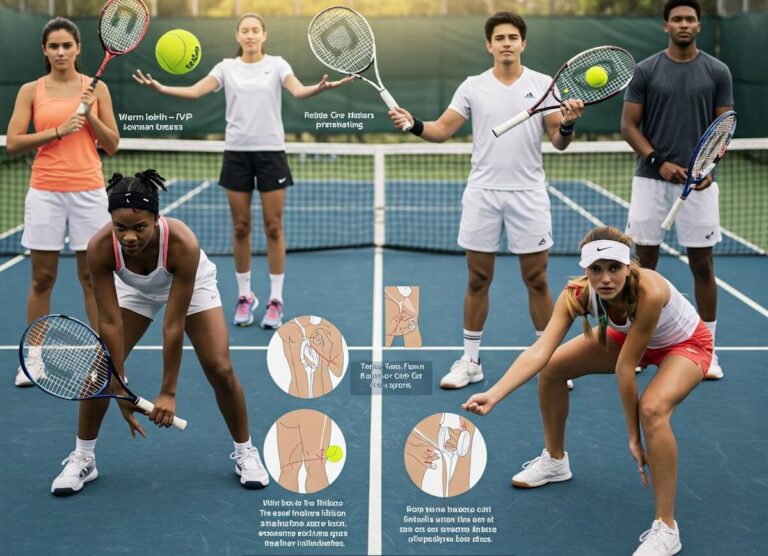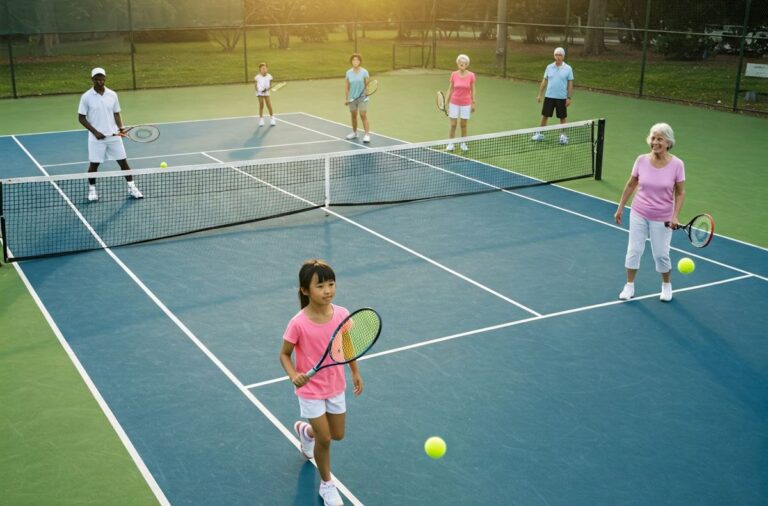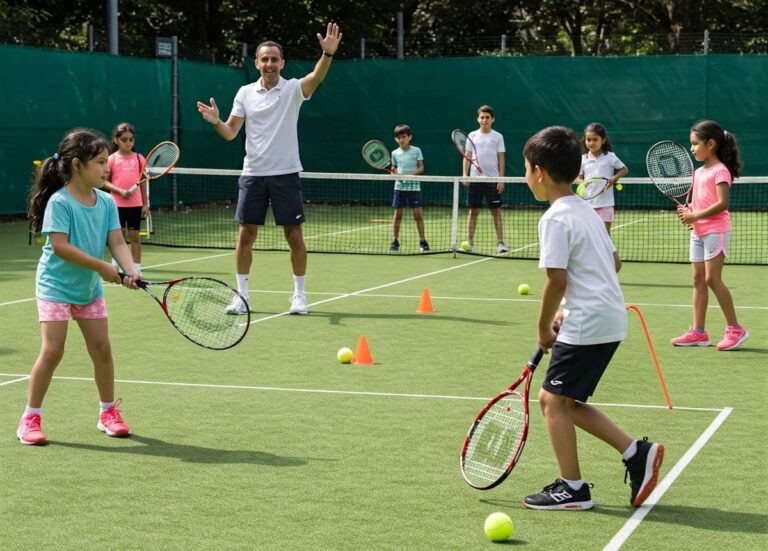Introduction to Tennis Court Surfaces
Tennis is a sport deeply influenced by the surface upon which it is played. The three primary types of tennis court surfaces—grass, clay, and hard courts—each present unique characteristics that significantly impact gameplay, player performance, and overall match outcomes. Understanding these surfaces is essential for players, coaches, and enthusiasts who wish to appreciate the nuances of the game.
Grass courts are known for their speed and low bounce. Traditionally associated with prestigious tournaments like Wimbledon, this surface allows for fast-paced matches that often favor players with strong serve-and-volley skills. Statistics reveal that, historically, only about 6% of ATP Tour matches are played on grass, emphasizing its rarity and specialized nature.
In contrast, clay courts, which comprise approximately 30% of the ATP Tour events, offer a slower playing experience. The surface provides a higher bounce, allowing players to engage in longer rallies and strategize their play meticulously. Clay is also renowned for testing endurance, as matches often require players to exhibit physical resilience and mental fortitude. The famous clay-court tournament, the French Open, showcases the distinctive style of play associated with this surface, promoting baseline rallies and tactical shot placements.
Hard courts, representing nearly 64% of ATP matches, combine elements of both grass and clay, providing a balanced playing environment. The moderate bounce and speed encourage a diverse range of playing styles, catering to aggressive baseliners as well as all-court players. Major tournaments such as the US Open and the Australian Open exemplify the significance of hard courts in professional tennis.
In conclusion, the impact of different tennis court surfaces cannot be overstated, as each type influences the game’s pace, playing styles, and competitive outcomes. Understanding these differences allows players and spectators to appreciate the strategic layers inherent in professional tennis, ultimately enriching their experience of the sport.
Characteristics of Grass Courts
Grass courts are renowned for their distinctive attributes that significantly influence the way tennis is played. One of the most notable characteristics is the speed of the surface. Grass courts tend to offer a faster playing experience compared to other surfaces like clay or hard courts. This speed is due to the low friction between the ball and the grass, allowing for quick rallies and serving dynamics. Players often have a shorter time to react, making decisive shot selection essential.
The bounce on grass courts is another characteristic that sets them apart. Unlike the consistent and higher bounce provided by hard courts, the bounce on grass can be unpredictable. Players must adapt quickly, as the ball can hop and skid, varying significantly based on the court’s condition—wet grass versus dry grass could lead to different reactions in the ball’s trajectory. This unpredictability can favor players who possess a strong serve-and-volley game, as they can capitalize on rapid points.
Moreover, player movement on grass is distinct. The inherently slippery nature of grass requires athletes to be agile and possess precise footwork to navigate the surface effectively. This dynamic encourages a style of play that often favors aggressive net play and quick exchanges. Grass courts can, however, be less forgiving for players who focus on baseline rallies and longer, drawn-out points, as maintaining balance can become a challenge.
Maintaining grass courts is a year-round commitment that involves regular mowing, watering, and weeding to ensure the surface remains in prime condition. Such maintenance is crucial, as it directly impacts the consistency and integrity of play. The interplay of these characteristics—speed, bounce, movement dynamics, and maintenance—highlights the unique demands and strategies that define the game on grass courts. Understanding these facets is essential for players looking to harness the advantages offered by this traditional surface.
The Dynamics of Clay Courts
Clay courts present a unique playing experience due to their distinct characteristics, which significantly affect how the game of tennis is played. One of the defining features of clay courts is their slower pace compared to grass or hard courts. The surface’s composition allows players to implement a strategic style of play that revolves around durability and tactical shot placement. As a result, the slower ball speed demands that players engage more in baseline rallies, which can extend points and tests their endurance levels over longer matches.
The higher bounce of the tennis ball on clay courts adds another layer of complexity to player strategy. Players often have to adjust their strokes and anticipate the ball’s trajectory more acutely, as the ball tends to rise higher after it strikes the surface. This phenomenon encourages players to utilize topspin to maintain control and depth in rallies while compelling opponents to adapt their positioning and timing. Consequently, matches on clay courts can become a strategic battle of attrition, where maintaining a solid baseline game is paramount.
Another crucial skill that clay court players must master is the sliding technique, which enables them to reach balls more effectively. Sliding allows players to maintain momentum and balance while changing direction rapidly, making it essential for successful movement across the court. This technique not only assists in reaching the ball but also in positioning for the next shot, a critical element in constructing effective points. However, mastering this skill presents its own challenges, as incorrect sliding can lead to slips or loss of balance during high-intensity exchanges.
Although clay courts offer unique opportunities for strategic gameplay, they also introduce challenges that can test the resilience and adaptability of players. Embracing the dynamics of clay courts requires a nuanced understanding of the game’s flow and an emphasis on physical endurance.
Exploring Hard Courts
Hard courts are universally recognized as the most prevalent surface in professional tennis, offering a unique blend of speed and control that greatly influences player performance. Typically made from materials such as acrylic and asphalt, hard courts present a consistent playing experience characterized by its firm surface, which enables players to execute a diverse range of shots effectively. The combination of speed and grip provided by hard courts allows athletes to engage in aggressive baseline rallies while also permitting deft net play.
The balanced nature of hard courts impacts shot selection as players often rely on a combination of power and precision. With a relatively low friction coefficient, hard courts allow the ball to travel faster compared to other surfaces such as clay and grass. This speed can enhance the effectiveness of powerful serves and groundstrokes, prompting players to develop a strategic approach that maximizes their competitive advantage. However, the quick pace also necessitates rapid reaction times and precise shot execution, which can elevate the level of skill required for successful gameplay.
In terms of injury risk, hard courts can present both benefits and challenges. The rigid surface offers less give, which may lead to a higher incidence of joint-related injuries, particularly in the knees and ankles. Players must be cognizant of their footwork and movement patterns to minimize strain and maintain longevity in their careers. Additionally, the variations within hard court types, including differences in surface texture and altitude, can further influence how the ball behaves and subsequently impact player strategies during matches. Overall, hard courts stand as a vital context in which players must adapt their styles to thrive effectively.
Player Preferences and Adaptability
Players’ preferences for tennis courts are often as diverse as their playing styles. Individual styles and strengths can significantly influence which surface players feel most comfortable on. For instance, some players, notably those with a strong baseline game, may favor clay courts due to the slower surface that allows for longer rallies and strategic play. Celebrated clay court specialist Rafael Nadal has frequently remarked on the advantages of clay for his game, which emphasizes endurance and tactical shot-making. In contrast, players with powerful serves and quick volleying skills, such as Roger Federer, may prefer the faster pace of grass courts, as they can leverage their aggressive style to dominate points quickly.
Adaptability becomes an essential skill for players aiming to succeed across various surfaces. Each court type demands a distinct approach and strategic adjustments. For instance, hard courts, which offer a good balance between speed and bounce, have become increasingly popular among players. Noted professional Serena Williams once articulated the importance of versatility in adjusting one’s game. Players often incorporate specific drills into their training regimens to enhance their adaptability. Drills focused on footwork, shot precision, and tactical awareness are crucial for anyone looking to excel on multiple surfaces.
Furthermore, factors like climate and court maintenance also play a role in performance and preferences. Clay courts can become slower and more difficult to play on during rainy conditions, while grass courts may present unpredictable bounces depending on the wear of the surface. Thus, players often need to prepare meticulously for tournaments in different conditions. Understanding these dynamics lays the groundwork for successful performance on any surface, demonstrating that player preferences are not merely a matter of comfort but also a reflection of adaptability and preparation.
Impact on Playing Style and Strategy
The type of tennis court surface significantly influences both the style of play and the strategies employed by athletes. Each surface—grass, clay, and hard court—offers distinct characteristics that cater to different playing styles. Understanding these nuances is essential for players to optimize their performance and capitalize on their strengths.
Grass courts, known for their speed and low bounce, favor serve-and-volley players. This surface encourages aggressive tactics, as the ball moves quickly and players have less time to react. A swift serve followed by an immediate approach to the net can be quite effective, allowing for quick points. However, the slick nature of the grass can also lead to unexpected bounces, challenging players to adapt their strategies accordingly.
In contrast, clay courts present a slower playing environment with higher, more unpredictable bounces. This surface suits baseline players who excel in rallies and constructing points. The slower pace allows for longer exchanges, drawing out opponents and providing opportunities to exploit weak shots. Players may adopt a more defensive strategy, utilizing top-spin shots that keep the ball in play and create angles. However, this can also lead to longer matches, testing the physical endurance of players.
Hard courts, often considered a middle ground, allow for a blend of strategies. These surfaces provide a consistent bounce while maintaining reasonable speed. Players can effectively switch between aggressive serving and net play or rely on baseline tactics, depending on their strengths. The versatility of hard courts attracts a wide range of playing styles, making it a popular choice for tournaments. Understanding the interplay between surface and strategy is crucial for players aiming to enhance their performance across different courts.
Ultimately, each surface poses unique challenges and advantages that influence how players approach their game. By recognizing these factors, athletes can develop tailored strategies to maximize their potential on the court.
Surface Influence on Major Tournaments
The impact of court surfaces on outcomes in major tennis tournaments cannot be overstated. Each surface—grass, clay, and hard court—imparts distinctive characteristics that influence player performance and match results. Grand Slam tournaments, the pinnacle of professional tennis, each have a designated surface type that fundamentally shapes the play style and strategies employed by competitors.
Wimbledon, held on grass courts, historically favors players with strong serve-and-volley tactics. The grass surface allows for a low bounce and rapid ball speeds, often benefiting aggressive players who can capitalize on these conditions. Iconic champions of Wimbledon, such as Roger Federer and Pete Sampras, exemplify the successful execution of strategies tailored to grass, showcasing how surface familiarity can enhance competitive edge. Conversely, players lacking proficiency on grass may struggle significantly during the tournament.
In contrast, the French Open takes place on clay courts, a surface known for its slower pace and higher bounce. Clay demands a different skill set, favoring baseline players who excel in constructing points and engaging in longer rallies. The gritty nature of clay often leads to grueling matches, making endurance an essential factor. Past champions such as Rafael Nadal have dominated at Roland Garros largely due to their ability to adapt and thrive on clay. Historical performances indicate a clear trend where players skilled on this surface consistently advance further in the tournament.
Hard courts, utilized in both the Australian Open and the US Open, present a middle ground between grass and clay. These surfaces accommodate a hybrid playing style, supporting both aggressive and defensive strategies. The varying characteristics of hard courts—with their potential for faster or slower play—means adaptability is crucial. Players like Novak Djokovic have leveraged versatility to succeed on hard courts, demonstrating how different surfaces can influence the direction of matches and the tournament as a whole.
Ultimately, the specific characteristics of each surface shape not only player performance but also the overall dynamics of the tournaments themselves, making surface selection a pivotal aspect of tennis at the highest level.
Injury Risks and Surface Impact
The choice of court surface significantly influences the incidence and type of injuries experienced by players in racquet sports. Grass, clay, and hard courts each present unique characteristics that affect footwork, joint impact, and overall player movement, resulting in varying injury risks. For instance, grass courts, while offering a softer landing, can lead to ankle sprains due to the uneven surface and sudden slipping. Additionally, the natural grass can become worn in specific areas, causing unexpected changes in footing that increase the risk of injury.
On the other hand, clay courts provide a more forgiving surface in terms of shock absorption, yet they can lead to a higher incidence of overuse injuries, such as tendinitis, particularly in the knee and elbow. The slower playing style on clay courts often results in longer rallies, placing significant stress on joints and muscles. Furthermore, the sliding motion required on clay can increase the risk of hamstring strains if players are not adequately conditioned.
Hard courts, composed of materials like asphalt or concrete, are the most injury-prone due to their rigid nature, which transmits greater impact forces to players’ bodies. Common injuries associated with hard courts include stress fractures, ankle injuries, and chronic joint pain, particularly affecting the knees and hips. The durability of hard courts may provide consistent playing conditions, but this comes at the expense of potential long-term damage to athletes.
To mitigate these injury risks, proper footwear is essential. Players should choose shoes specifically designed for their surface, ensuring adequate support and cushioning. Additionally, conditioning and strength training tailored to the demands of the chosen surface can help alleviate stress on joints and muscles. By understanding the injury risks associated with each court type and implementing preventive measures, players can enhance their performance while reducing the likelihood of injuries throughout their careers.
Conclusion: Choosing the Right Surface for Your Game
In summary, understanding the differences between grass, clay, and hard courts is essential for any tennis player looking to refine their skills and enhance their performance. Each surface offers unique characteristics that can significantly affect gameplay and strategy. Grass courts allow for faster play and a lower bounce, favoring players with strong serve-and-volley techniques. Clay courts, on the other hand, provide a slower game with a higher bounce, encouraging endurance and strategic placement of shots. Hard courts combine elements from both surfaces, presenting a balanced challenge that can benefit a variety of playing styles.
For amateur players, the choice of playing surface can influence practice routines and skill development. It is advisable to engage in regular practice on different surfaces to cultivate versatility in your gameplay. Such practice not only helps in adapting to various playing conditions but also strengthens overall game strategy. Players should work on specific techniques that align with the surface they are practicing on; for example, focusing on drop shots and topspin strokes on clay can lead to improved performance in competitive matches.
Moreover, recognizing your own playing style will inform the selection of the ideal surface. Players who excel in power and speed may find grass courts suitable, while those who prefer a tactical, baseline-oriented strategy might thrive on clay. Ultimately, integrating experiences from various surfaces will enhance adaptability, preparing players for diverse competitive environments. By comprehensively understanding each surface and how it complements individual skills, amateur players can make informed decisions that promote growth and improvement in their game.



